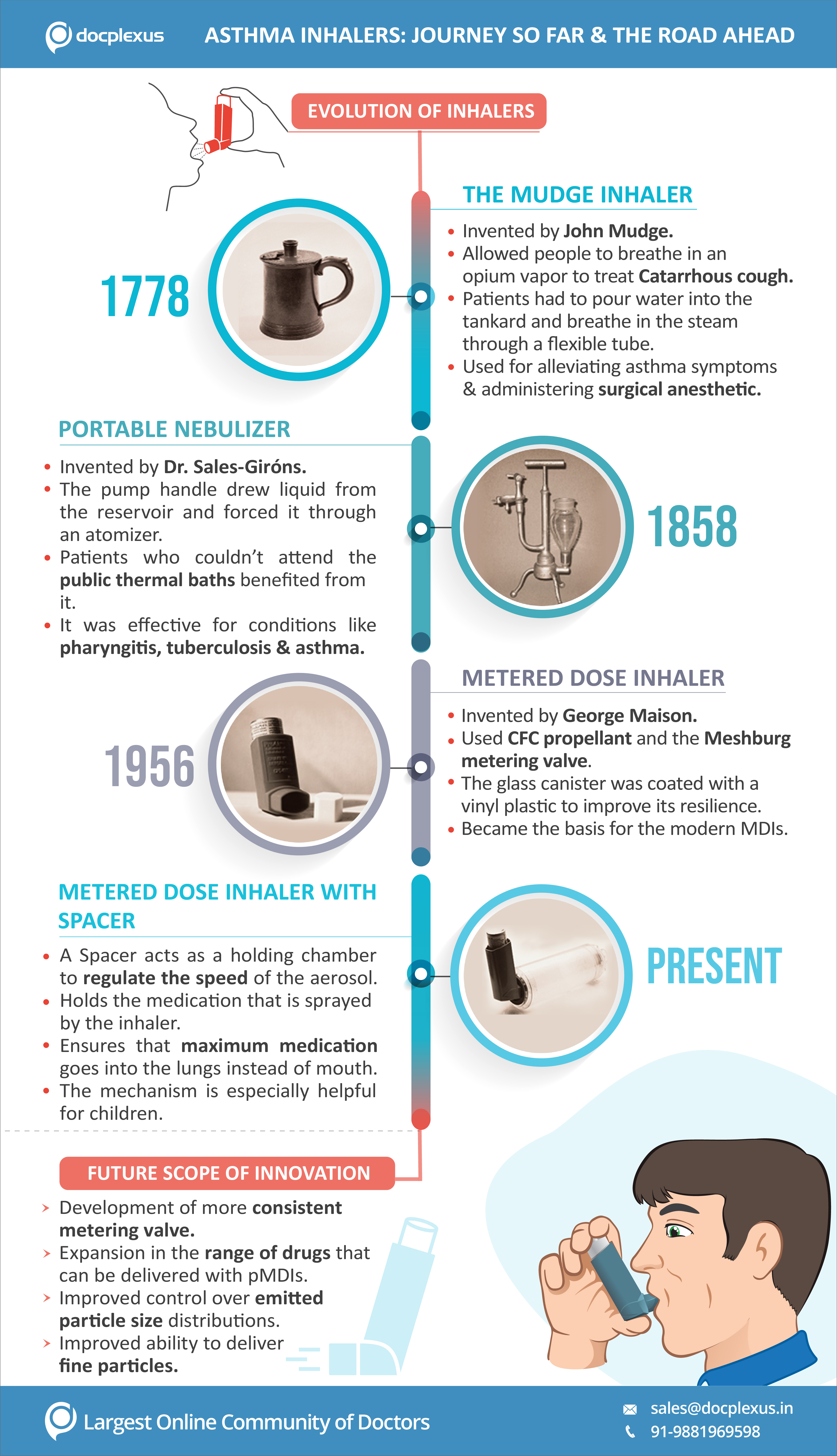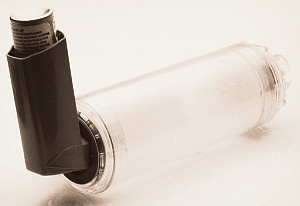
Up until 1960s, Asthma was seen as a psychological condition. People used to consider a child’s wheezing sound as a distress call for his or her mother. So, it is fair to say that Asthma Inhalers have gone through a whole lot of revelation. And it is true not just for the disease but for its treatment too.
For over 3,500 years, people have inhaled a variety of substances to cure Asthma. From smoking opium to inhaling the fumes of herbs to modern medication like Albuterol, the journey has been fascinating.
Even the mechanisms to inhale the substance have gone through a series of innovation. The replacement of chlorofluorocarbons propellants with hydrofluorocarbon propellants has resulted in the redesign of Metered-dose Inhalers (MDIs).
In this write-up, we are gliding into the evolution of inhalers over the centuries. Talking about the past makes the present meaningful, but talking about the future makes the present purposeful. Therefore, we are also throwing some light on the future scope of innovation in inhalers. So, let’s take you back to 18th Century.
1. The Mudge Inhaler – 18th Century

The name ‘Mudge Inhaler’ is derived from its inventor John Mudge, who was an English physician and created the first inhaler in 1778.
This unique invention allowed people to inhale opium vapor to treat ‘catarrhous cough’ (a cough with a lot of mucus). The patients would pour water and herbs like opium into the tankard, close the lid, and inhale the steam via a flexible tube.
They were required to keep the inhaler warm by tucking it under their arm. The handle of the tankard was hollow and had air inlet holes that allowed an influx of fresh air to mix with the steam.
The device became quite popular in both homes and hospitals. Apart from alleviating asthma symptoms, the Mudge Inhaler was also used for administering surgical anesthetic.
2. Portable Nebuliser – 19th Century

In 1858 the first portable nebulizer called as Pulverisateur was invented by Dr. Sales-Giróns. The pump handle (which was like a bicycle pump) drew liquid solution from the reservoir and forced it through an atomizer. It was a highly effective treatment for conditions like pharyngitis, tuberculosis, and asthma.
After a few years, the first steam-driven nebulizer was invented in Germany in 1864. It was called Siegle’s steam spray inhaler and used Venturi principle to atomize liquid medication. It consisted of spirit burner that turned water into steam.
The steam was then passed into the tube suspended in the pharmaceutical solution, as a result of which the medicine used to turn into vapors. Patients would eventually inhale the vapors using a mouthpiece made of glass.

3. Metered Dose Inhaler – 20th Century

In 1956, an alternative to nebulizer was invented by George Maison. It was called Pressurized Metered Dose Inhaler, as it could deliver exact doses of medicine using Meshburg metering valves. For improving the resilience of the device, the glass canister was coated with a vinyl plastic.
Interestingly, Maison was inspired by his 13-year-old daughter for this invention. She was suffering from severe Asthma and using a nebulizer for her treatment. As it was ineffective and not that user-friendly, she asked her father to create a perfume-bottle-like device that could deliver the medication right into her lungs. This incident catalyzed the invention of the first ever MDI, and it became the basis for the development of modern MDIs.
Another important component of an MDI is its propellant. It is the powerhouse that generates ‘aerosol cloud’ and carries the active component. Around 99% of the delivered dose comprises of propellant only. So more than anything else, the properties of the propellant decide the efficacy of the device. The earliest propellant used was Chlorofluorocarbon (CFC). It was later replaced with hydrofluoroalkanes in the modern MDIs.
4. Metered Dose Inhaler With Spacers – 21st Century

The MDIs have undergone a few advancements since its invention. The most notable one being the integration of MDIs with Spacers.
Spacers or holding chambers are add-on devices that are attached to the Inhaler and reduces the speed at which the aerosol enters the mouth. They improve the user-friendliness of Inhalers and make sure that the maximum amount of medication goes into the lungs instead of remaining in the mouth.
As they prevent the medicine from going into the mouth, they help the patients, especially children, in avoiding oral yeast infections and dysphonia.
The Future Scope of Innovation in Asthma Inhalers
The journey of Asthma Inhalers has been enterprising so far, but still there are gaps when it comes their design and mechanism. Can chronic Asthmatic conditions be treated effectively through MDIs? Can a wide range of diseases be treated via them? These are important questions to answer, and following should be the focus areas for future innovation:
i) Development of more consistent metering valves
ii) Enhancement in breath-actuated devices
iii) Better control over emitted particle size distribution
iv) Specialized devices for pediatric and geriatric patients
v) Expansion in the range of drugs that can be delivered with Pressurized Metered Dose Inhalers (pMDIs)
New pMDI formulations have shown that the ability to deliver fine particles allows aerosols to penetrate deeper into the lungs and treat Small Airways. These airways have a diameter of <2mm and may get chronically inflated in Asthmatic patients. Currently, there is a lot of interest around ‘extrafine’ aerosols (diameter of <2 µm), in their ability to effectively target Small Airways.
If we talk about Inhaler design, the biggest innovation so far has been the development of Soft Mist Inhaler (SMI). This newest mechanism uses the energy of a compressed spring to convert an aqueous liquid solution into an inhalable vapor. An SMI is an enhanced alternative to Pressurized Metered Dose Inhalers as it does not require propellants or patients’ inspiratory efforts to generate the aerosol. Owing to such advanced characteristics, more SMI-based delivery systems should be there in the future.
There is a lot of excitement around new biopharmaceuticals, and there is an expanding need of high-dose delivery devices. The focus of innovation is rightly shifting towards the delivery of microparticles, nanoparticles, small molecules, and biomacromolecules. To make the drug delivery (to lungs) more targeted and accurate, pharma industry should adopt ‘Open Innovation’ as a way forward. Collaborative research within the pharma industry is the need of the hour to streamline the pathways to innovation.
We hope this write-up evoked nostalgia, and it informed and captivated you equally. Do share your views in the comment section and suggest topics that you want us to write on. You can also reach us at sales@docplexus.in/ +91 9881969598
Docplexus – Pharma’s Trusted Marketing Partner
Docplexus is one of the world’s largest & fastest-growing networks of verified doctors & a trusted marketing partner of pharma, medical devices, diagnostics & nutraceutical companies. We empower our industry partners to meaningfully engage with the medical community through data-driven, evidence-based marketing & brand management solutions such as infocenter (branded microsite), mindset analysis, KOL webinars, sponsored medical updates, online CMEs & more.
